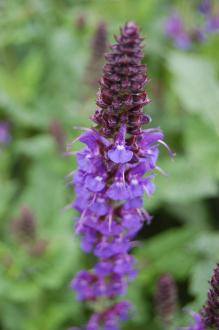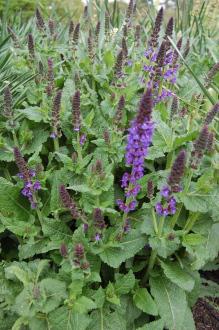
Salvia x sylvestris ‘Mainacht’ Flower (05/05/2012, Kew Gardens, London)
Position: Full sun to light shade
Flowering period: Late spring to early summer
Soil: Moist, well drained
Eventual Height: 70cm
Eventual Spread: 50cm
Hardiness: 4a -9b
Family: Lamiaceae
Salvia x sylvestris ‘Mainacht’ is an erect, clump forming, deciduous herbaceous perennial. Its dark green leaves are oblong to lance shaped with scalloped margins and are wrinkly. Its blue/ purple flowers appear in densely packed terminal racemes and are up to 18cm long.
Salvia x sylvestris, commonly known as Wood Sage or Perennial Woodland Sage, is a hybrid between Salvia nemorosa and Salvia pratensis. Salvia x sylvestris ‘Mainacht’ is commonly known as Wood Sage ‘Mainacht’.
The etymological root of the binomial name Salvia is derived from the Latin salvare, meaning to ‘save’ or ‘heal’, in reference to its historical use as a medicinal plant. Sylvestris is derived from the Latin silva meaning ‘wood or forest’. Mainacht is from the German meaning ‘May Night’.

Salvia x sylvestris ‘Mainacht’ (05/05/2012, Kew Gardens, London)
The landscape architect may find Salvia x sylvestris ‘Mainacht’ useful in low maintenance, prairie type schemes. It is also useful in wildlife gardens due to its attractiveness to insects. Once established this plant is drought tolerant.
Ecologically, S. x sylvestris ‘Mainacht’ is very attractive to pollinating insects.
The Royal Horticultural Society has given S. x sylvestris ‘Mainacht’ their prestigious Award of Garden Merit in 1996.
S. x sylvestris ‘Mainacht’ prefers moist, fertile, well-drained soils. It tolerates most pH of soil.
Salvia x sylvestris ‘Mainacht’ requires little maintenance. After flowering the flower heads may be removed to encourage a second flush of flowers. Large clumps may be divided in spring or autumn.

